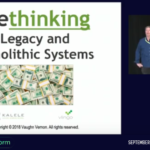Vaughn Vernon's Blog
July 9, 2019
Hello world!
Welcome to WordPress. This is your first post. Edit or delete it, then start writing!
The post Hello world! appeared first on Vaughn Vernon Domain-Driven Design.

October 10, 2018
Vaughn Vernon – Rethinking Legacy and Monolithic Systems, Spring One Platform 2018

Legacy monoliths have generated profit for decades. Gradually the myriad of changes to these revenue generators have lead to a paralyzing tangle. The recurring plea for help? Teams are demoralized by the mud, and hardware has outpaced software architecture. How can you achieve mobility and relief? I discuss practical steps that can be made toward enterprise modernization. Speakers: Vaughn Vernon Implementing Domain-Driven Design, Author Filmed at SpringOne Platform 2018
Re: https://content.pivotal.io/springone-...
Re: Vaughnvernon.co
The post Vaughn Vernon – Rethinking Legacy and Monolithic Systems, Spring One Platform 2018 appeared first on Vaughn Vernon and Implementing Domain Driven Design —.

October 8, 2018
Vaughn Vernon – Event Storming for Fun and Profit

The post Vaughn Vernon – Event Storming for Fun and Profit appeared first on Vaughn Vernon and Implementing Domain Driven Design —.

September 17, 2018
Vaughn Vernon – GOTO, Berlin 2017 • DDD Today “Modeling Uncertainty”


January 25, 2018
A vlingo/actors Tutorial

With the continuous news about the vlingo/platform you’ve probably been wondering how you can put the reactive goodness to use. Here I explain how the use vlingo/actors to achieve asynchronous messaging between objects, which are implemented as actors.
First, create your own playground project to work with. If you create a Maven-based project you will need to place a dependency into your playground’s pom.xml file.
...
io.vlingo
vlingo-actors
0.4.8
...
If you prefer Gradle over Maven, insert the following into your build.gradle:
dependencies {
compile 'io.vlingo:vlingo-actors:0.4.8'
}
repositories {
jcenter()
}
Actually, also add this one for junit since you’ll be using it in this tutorial.
...
junit
junit
4.11
test
...
NOTE: If you would like to run with a reasonable default configuration, skip the following step of creating a vlingo-actors.properties file and move on to the Java source code implementation.
Now open your playground project. In the Maven src/test/resources directory (IDE folder), create a file named vlingo-actors.properties and place the following properties in it.
# vlingo-actors.properties for my playground
plugin.name.queueMailbox = true
plugin.queueMailbox.classname = io.vlingo.actors.plugin.mailbox.concurrentqueue.ConcurrentQueueMailboxPlugin
plugin.queueMailbox.defaultMailbox = true
plugin.queueMailbox.numberOfDispatchersFactor = 1
plugin.queueMailbox.dispatcherThrottlingCount = 10
plugin.name.jdkLogger = true
plugin.jdkLogger.classname = io.vlingo.actors.plugin.logging.jdk.JDKLoggerPlugin
plugin.jdkLogger.name = playground
plugin.jdkLogger.defaultLogger = true
plugin.jdkLogger.handler.classname = io.vlingo.actors.plugin.logging.jdk.DefaultHandler
plugin.jdkLogger.handler.name = vlingo
plugin.jdkLogger.handler.level = ALL
Now to the code. You need to create a few Java interfaces and classes. There’s a Java interface that acts as the type safe messaging protocol of the first actor that you will create. For now, create a Pinger interface with a single method definition, named ping, which takes a Ponger as a parameter.
package playground;
import io.vlingo.actors.Stoppable;
public interface Pinger extends Stoppable {
void ping(final Ponger ponger);
}
Next create a Ponger interface the same way, but with a pong() method that takes a Pinger as a parameter.
package playground;
import io.vlingo.actors.Stoppable;
public interface Ponger extends Stoppable {
void pong(final Pinger pinger);
}
Now you have two protocols. These define the type safe behaviors that one or more actors will implement, and the means by which clients will interact with the actors. In case it’s not obvious, Pinger is a client of Ponger, and Ponger is a client of Pinger.
It’s time to create two simple actors. First create one to implement the Pinger protocol.
package playground;
import io.vlingo.actors.Actor;
public class PingerActor extends Actor implements Pinger {
private final Pinger self;
public PingerActor() {
self = selfAs(Pinger.class);
}
public void ping(final Ponger ponger) {
ponger.pong(self);
}
}
After that, create another actor to implement the Ponger protocol.
package playground;
import io.vlingo.actors.Actor;
public class PongerActor extends Actor implements Ponger {
private final Ponger self;
public PongerActor() {
self = selfAs(Ponger.class);
}
public void pong(final Pinger pinger) {
pinger.ping(self);
}
}
You now have two actors that collaborate to play ping pong. The problem is that these actors will play ping pong nonstop, forever, unless we do something to prevent that. Doing so demonstrates how actors can maintain their own state, just like typical objects.
package playground;
import io.vlingo.actors.Actor;
public class PingerActor extends Actor implements Pinger {
private int count;
private final Pinger self;
public PingerActor() {
count = 0;
self = selfAs(Pinger.class);
}
public void ping(final Ponger ponger) {
if (++count >= 10) {
self.stop();
ponger.stop();
} else {
ponger.pong(self);
}
}
}
Looking back at the Pinger and Ponger interface definitions, you will notice that both of these protocols extend the Stoppable protocol. Thus, they can both be stopped by other actors that have a Stoppable reference to them. We use that capability from within PingerActor to cause both actors to stop when the count reaches 10.
Note that in this case the actors are not required to implement their own stop() methods. That’s because the abstract base class, Actor, implements stop() for them. You could override stop() to find out when your actor is being stopped, but that’s not necessarily a good idea. What if you forgot to invoke the super’s stop()? That would make you think that your actor was going to stop, but the actor would never shut down because the Actor base class behavior would never be run. If you want to know when you are being stopped, you can override one of the four life cycle methods instead of stop().
package playground;
import io.vlingo.actors.Actor;
public class PingerActor extends Actor implements Pinger {
private int count;
private final Pinger self;
public PingerActor() {
count = 0;
self = selfAs(Pinger.class);
}
public void ping(final Ponger ponger) {
if (++count >= 10) {
self.stop();
ponger.stop();
} else {
ponger.pong(self);
}
}
@Override
protected void afterStop() {
logger().log("Pinger " + address() + " just stopped!");
super.afterStop();
}
}
All four life cycle methods are:
beforeStart()
afterStop()
beforeRestart(final Throwable reason)
afterRestart(final Throwable reason)
These enable you to see when significant life cycle events occur with your actor. The restart life cycle methods are related to actor supervision. When your actor’s supervisor sees your actor fail with an Exception, it can take a number of actions. Your supervisor can tell your actor to resume, to stop, or to restart. When it tells your actor to restart, the beforeRestart() is invoked first, and then the afterRestart() is invoked. Since your actor has failed, it may have been left in an invalid state. In such cases, these two life cycle methods give your actor the opportunity to clean up after itself and reinitialize itself before reacting to its next available protocol message.
The above afterStop() method shows two additional perks of vlingo/actors. All actors have a personal address, which is available through your inherited address() method. Also, all actors have a Logger available via its logger() method.
Alright, we have two actors, but how do we bring the actors to life in the first place, and how do we get them to start collaborating in game play? Here’s how you start up the World for your actors to play in.
package playground;
import org.junit.Test;
import io.vlingo.actors.Definition;
import io.vlingo.actors.World;
public class PlaygroundTest {
@Test
public void testPlayPingPong() {
final World world = World.start("playground");
final Pinger pinger = world.actorFor(Definition.has(PingerActor.class, Definition.NoParameters), Pinger.class);
final Ponger ponger = world.actorFor(Definition.has(PongerActor.class, Definition.NoParameters), Ponger.class);
pinger.ping(ponger);
pauseThisThread();
world.terminate();
}
}
When this test is run, a World is created. You can reference a previous post about the various major components of vlingo/actors, one of which is World. In a nutshell, a World is the primary container within which actors live and play.
Next, two actors are created, and a reference to their respective protocol is returned. Each actor is created by means of a Definition. The Definition indicates the class of the actor that implements the protocol, such as PingerActor.class, which implements the Pinger.classprotocol. Note that in this example neither actor takes constructor parameters. If they did, you would replace the Definition.NoParameterswith a list of parameters in the order that the constructor takes them.
final Pinger pinger = world.actorFor(
Definition.has(
PingerActor.class,
Definition.parameters("Hey, yo!", 42),
"name-that-actor"),
Pinger.class);
This demonstrates that a Definition can be used to define parameters and various actor characteristics, such as it’s text string name. Look over the source code for the several different ways that an actor can be created, including with a specific parent, a non-default logger, and a specialized supervisor.
One last point about the unit test is appropriate. As you noticed, a method named pauseThisThread() is used. Some sort of coordination is necessary because the actors send and receive all protocol messages asynchronously, and recall that there will be a total of 10 pings. Since the messages are all delivered and reacted to asynchronously, there is no “automatic” way to know when all the messages, including the stop() for both actors, have been delivered. In a later tutorial I will show you how you can more conveniently test actors without using such a “thread sleep” artifice. But for how just be aware that the Actor Model discards the blocking and synchronous programming model that most programmers are familiar and comfortable with. Don’t get used to this, but here is an implementation for this playground test.
...
private void pauseThisThread() {
try { Thread.sleep(100); } catch (Exception e) { }
}
...
In order to make the ping pong produce some output, create some log output in the ping() and pong() methods:
// in Pinger
...
public void ping(final Ponger ponger) {
++count;
logger().log("ping " + count);
if (count >= 10) {
self.stop();
ponger.stop();
} else {
ponger.pong(self);
}
}
...
// in Ponger
public void pong(final Pinger pinger) {
logger().log("pong");
pinger.ping(self);
}
...
I hope this brief tutorial has given you the incentive to dive into vlingo/actors and discover the other beautiful and powerful programming experiences ahead of you!

June 13, 2016
Vaughn Vernon on Developing a Domain Driven Design First Actor-Based Microservices Framework

Vaughn Vernon is thought-leader in the space of reactive software and Domain Driven Design (DDD). Vaughn has recently released a new open source project called vlingo. The platform is designed to support DDD at the framework and toolkit level. On today’s podcast, Vaughn discusses what the framework is all about, why he felt it was needed, and some of the design decisions made in developing the platform, including things like the architecture, actor model decisions, clustering algorithm, and how DDD is realized with the framework.
Ref: https://www.infoq.com/podcasts/ddd-microservices-framework
player.bind(SC.Widget.Events.PLAY, function() {
if (milliseconds >= 0) {
player.seekTo(milliseconds);
}
});
seekTo = function(minutes, seconds) {
milliseconds = ((minutes * 60) + seconds) * 1000;
player.isPaused(function isPaused(p) {
if (p == true) {
player.play();
} else {
player.seekTo(milliseconds);
}
});
}

May 18, 2016
Three Implementations of vlingo/streams

If you are interested in software designs that feature concurrency, I think you will enjoy this post comparing multi-threading with component development using the Actor Model and actors. Employing the Actor Model means that your components are built using actors. Actors are objects, but ones that send and receive messages asynchronously, and that support concurrent and parallel processing when run on multi-core hardware. If you as of yet don’t know much about this programming model, take a look at these explanations of the Actor Model and actor development.
While developing the vlingo/streams component of the vlingo/platform I purposely produced multiple implementations. I first employed a single-threaded, blocking model. Of course this had latency written all over it, but I knew that a single-threaded request handler would lead to that. Besides reaching observable proof of the disadvantages, I could use this code to refactor into a multi-threaded model. That way I would tend to introduce the complexity of multi-threading only where necessary.
The result of the multi-threaded code performed much better than the single-threaded, of course, but it yielded disadvantages, too. It was difficult to manage thread usage at any given point during request handling. To address this, I created queue-based message dispatchers. I could assign a certain number of threads to each dispatcher queue, attempting to prevent the creation of “too many threads” and the depletion of precious system resources.
Designing a balanced workflow between total thread availability and consumption was challenging, yet doable. The primary problem, however, was the lack of explicit division of work and the inability to predict the time of completion of any given task under heavy load. Admittedly some of the threading complexity could have been managed by the use of the Java Executor, but this still didn’t solve the problem of assigning specific components to specific queue types, and determining how many components would best service a given part of the overall request handling process. Introducing threads and queues in places where I did not initially foresee led to unintentional complexity (not really accidental complexity because I understood why I chose a given design). It wasn’t a tangled mess, but it wasn’t tasteful to me.
Enter the Actor Model with the use of vlingo/actors. I redesigned the overall approach more intentionally because I could easily visualize where actors should be used. Introducing actors at non-critical points leads to unnecessary messaging overhead. Consider using internal actor behavior rather than introducing another actor where low latency data access is critical. Direct access of privately owned data while an actor is handling its current message achieves much better throughput than delegating to other actors when circumstances don’t require it.
What problems does the vlingo/streams component solve? Stay tuned for more information on the way!
If you have yet to look at our vlingo/platform, this blog post introduces you to the architecture. The open source vlingo/platform repositories are available here.

Vaughn Vernon's Blog
- Vaughn Vernon's profile
- 107 followers









